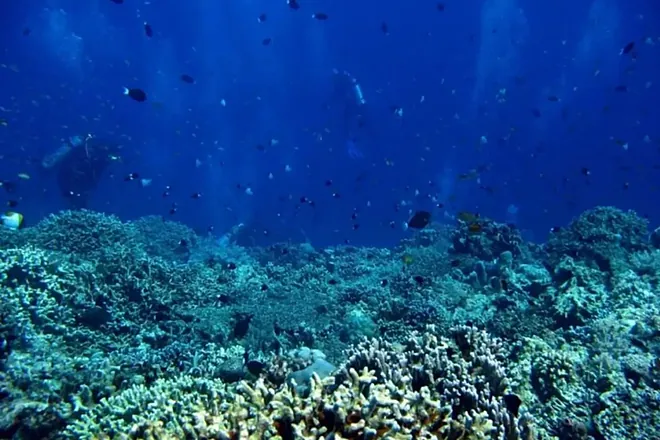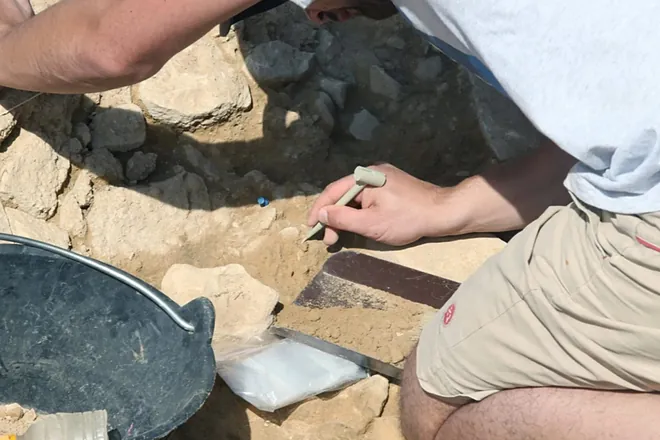A submerged metropolis has been discovered in the depths of the Atlantic Ocean, sparking global headlines and reviving humanity’s fascination with Atlantis. Scientists have revealed a network of massive craters and hydrothermal activity on the seafloor that could reshape our understanding of Earth’s hidden ecosystems.
The finding, published in Science Advances, is centered on a newly identified site researchers have named Kunlun — a mysterious hydrothermal system with striking geological features and thriving marine life.

What Is the Kunlun Hydrothermal System?
Far below the waves, about 80 kilometers west of the Mussau Trench on the Caroline Plate, researchers uncovered a network of more than 20 giant craters spread across roughly 11 square kilometers. Some depressions are over a kilometer wide and plunge more than 130 meters deep.
Scientists describe this alien-like landscape as a “submarine metropolis” because of its size, scale, and ecological richness. Instead of skyscrapers and roads, the craters are rimmed with mineral formations, teeming with life forms adapted to darkness and chemical energy.
How Do These Underwater Craters Form?
The Kunlun system was created by a geological process called serpentinization, which occurs when seawater penetrates the oceanic crust. The chemical reactions between water and rock release large amounts of hydrogen gas and other reduced compounds.
At Kunlun, hydrogen concentrations are unusually high — up to 5% of the estimated local levels — making this one of the richest hydrogen-producing environments discovered so far. This chemical energy feeds unique microbial communities, which in turn support larger animals.
Life in the Underwater Metropolis
Despite the crushing pressure, frigid darkness, and lack of sunlight, life thrives at Kunlun. Researchers documented crabs, tubeworms, shrimp, squat lobsters, and anemones clustered around vent openings.
These organisms rely on chemosynthesis, where microbes convert hydrogen and other chemicals into usable energy. It’s a process that mirrors conditions on early Earth — and may hint at how life began on our planet billions of years ago.
Why the Discovery Matters
Kunlun isn’t just another deep-sea curiosity. It carries implications for several major fields of science:
- Origins of Life Research: Hydrothermal systems are prime candidates for where life first emerged. Kunlun adds new evidence to this theory.
- Astrobiology: Similar hydrogen-rich vents could exist on icy moons like Jupiter’s Europa or Saturn’s Enceladus, boosting the possibility of extraterrestrial life.
- Energy Science: Abiotic hydrogen production could one day inform clean energy research.
- Marine Biodiversity: The discovery expands our understanding of ecosystems far from mid-ocean ridges, showing life can flourish in unexpected places.
The Atlantis Connection
It’s no surprise that media coverage has linked Kunlun with Atlantis, the legendary lost city described by Plato. The term “metropolis” makes for irresistible headlines.
But here’s the truth: Kunlun is not a man-made city. There are no ruins, temples, or walls under the waves — only natural geology sculpted by chemical forces. Still, discoveries like this fuel the imagination and keep the Atlantis mystery alive. If entire crater networks can exist unseen for millennia, who knows what else the ocean is hiding?
Kunlun vs. The Lost City Hydrothermal Field
Interestingly, this is not the first time researchers have compared a seafloor discovery to a “city.” In the Atlantic Ocean, the Lost City hydrothermal field — discovered in 2000 — features towering carbonate chimneys that rise like skyscrapers from the seabed.
- Lost City lies on the Mid-Atlantic Ridge.
- Kunlun is located in the western Pacific, far from spreading ridges.
- Both are hydrogen-rich environments, but Kunlun is significantly larger in scale.
This comparison has fueled some confusion, with early reports mistakenly placing Kunlun in the Atlantic. In reality, the two sites are thousands of kilometers apart, yet equally fascinating.
Could the Ocean Be Hiding More “Metropolises”?
The discovery of Kunlun is a reminder of how little we know about the deep sea. Despite covering more than 70% of Earth’s surface, much of the ocean floor remains unexplored. Hydrothermal fields like Kunlun might be more common than we think — hidden worlds that challenge scientific paradigms.
As exploration technology improves — with manned submersibles, remotely operated vehicles, and advanced sonar mapping — scientists expect more discoveries that blur the line between science and myth.
The submerged metropolis of Kunlun is not Atlantis, but it’s every bit as awe-inspiring. With its hydrogen-rich vents, thriving deep-sea life, and sprawling crater network, it pushes the boundaries of what we know about Earth’s geology and biology.
Whether it revives the legend of Atlantis or sparks new dreams of alien oceans, Kunlun proves one thing: the deep sea remains one of humanity’s last great frontiers.
Quick Facts: The Kunlun “Submarine Metropolis”
| Feature | Details |
|---|---|
| Location | ~80 km west of Mussau Trench, Caroline Plate (Pacific) |
| Area | ~11 km² |
| Structures | ~20 giant craters, up to 1 km wide, 130 m deep |
| Key Process | Serpentinization → high hydrogen output |
| Life Found | Crabs, tubeworms, shrimp, lobsters, anemones |
| Importance | Origins of life research, astrobiology, biodiversity, clean energy potential |







